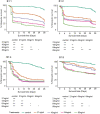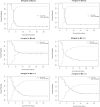A field bioassay for assessing ivermectin bio-efficacy in wild malaria vectors
- PMID: 37777725
- PMCID: PMC10542238
- DOI: 10.1186/s12936-023-04718-9
A field bioassay for assessing ivermectin bio-efficacy in wild malaria vectors
Abstract
Background: Ivermectin (IVM) mass drug administration is a candidate complementary malaria vector control tool. Ingestion of blood from IVM treated hosts results in reduced survival in mosquitoes. Estimating bio-efficacy of IVM on wild-caught mosquitoes requires they ingest the drug in a blood meal either through a membrane or direct feeding on a treated host. The latter, has ethical implications, and the former results in low feeding rates. Therefore, there is a need to develop a safe and effective method for IVM bio-efficacy monitoring in wild mosquitoes.
Methods: Insectary-reared Anopheles gambiae s.s. were exposed to four IVM doses: 85, 64, 43, 21 ng/ml, and control group (0 ng/ml) in three different solutions: (i) blood, (ii) 10% glucose, (iii) four ratios (1:1, 1:2, 1:4, 1:8) of blood in 10% glucose, and fed through filter paper. Wild-caught An. gambiae s.l. were exposed to 85, 43 and 21 ng/ml IVM in blood and 1:4 ratio of blood-10% glucose mixture. Survival was monitored for 28 days and a pool of mosquitoes from each cohort sacrificed immediately after feeding and weighed to determine mean weight of each meal type.
Results: When administered in glucose solution, mosquitocidal effect of IVM was not comparable to the observed effects when similar concentrations were administered in blood. Equal concentrations of IVM administered in blood resulted in pronounced reductions in mosquito survival compared to glucose solution only. However, by adding small amounts of blood to glucose solution, mosquito mortality rates increased resulting in similar effects to what was observed during blood feeding.
Conclusion: Bio-efficacy of ivermectin is strongly dependent on mode of drug delivery to the mosquito and likely influenced by digestive processes. The assay developed in this study is a good candidate for field-based bio-efficacy monitoring: wild mosquitoes readily feed on the solution, the assay can be standardized using pre-selected concentrations and by not involving treated blood hosts (human or animal) variation in individual pharmacokinetic profiles as well as ethical issues are bypassed. Meal volumes did not explain the difference in the lethality of IVM across the different meal types necessitating further research on the underlying mechanisms.
Keywords: Anopheles gambiae; Bio-efficacy; Field bioassay; Ivermectin; Kenya; Monitoring; Vector control; Wild vectors.
© 2023. BioMed Central Ltd., part of Springer Nature.
Conflict of interest statement
The authors declare that they have no competing interests including of financial or non-financial nature. Mention of trade names in this publication is solely for providing specific information and does not in any way imply endorsement by any of the authors or their respective affiliations.
Figures





References
-
- Smit MR, Ochomo E, Aljayyoussi G, Kwambai T, Abong'o B, Bayoh N, et al. Efficacy and safety of high-dose ivermectin for reducing malaria transmission (IVERMAL): protocol for a double-blind, randomized, placebo-controlled, dose-finding trial in Western Kenya. JMIR Res Protocols. 2016;5:e213. doi: 10.2196/resprot.6617. - DOI - PMC - PubMed
-
- Dabira ED, Soumare HM, Conteh B, Ceesay F, Ndiath MO, Bradley J, et al. Mass drug administration of ivermectin and dihydroartemisinin–piperaquine against malaria in settings with high coverage of standard control interventions: a cluster-randomised controlled trial in The Gambia. Lancet Infect Dis. 2022;22:519–528. doi: 10.1016/S1473-3099(21)00557-0. - DOI - PubMed
MeSH terms
Substances
LinkOut - more resources
Full Text Sources
Medical

